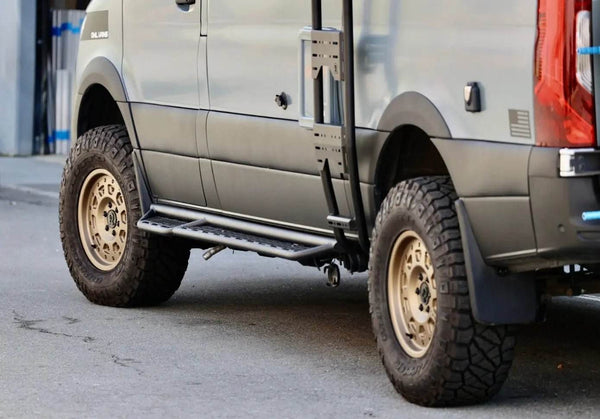The Owl Journal
Sprinter Van Wheels and Tires: A Guide for Upgrades
Your tires and wheels play a huge role in how the vehicle handles, whether that’s on highways, gravel forest roads, desert off-roading trails, or deep alpine snow. The wrong tires can leave you unequipped at best and in danger at worst.
There are countless configurations that you can consider when upgrading your Sprinter van wheels and tires. Understanding the differences in these options is key to having a van that rides well and overcomes any type of terrain. This guide will serve as your roadmap to building a Sprinter with wheels that are ready for any road, season, or destination.
Why the Right Mercedes Sprinter Wheels and Tires Matter
When it comes down to it, tires are the only thing keeping your van glued to the Earth, so it’s important that you choose the right ones for the job. Every van owner uses their rig differently; some like to push it to the extreme in places like Moab, whereas others just want a cool adventure-ready vehicle that turns heads at campgrounds.
Installing cheap MB Sprinter wheels and tires can lead to a range of headaches down the road, including getting stuck, veering off the road, and experiencing a blowout due to excessive cabin weight. If you put the thought into your van’s intended use and buy tires and wheels to match it, you’ll be prepared for anything.
3 Signs You Should Replace Your Sprinter Van Tires
While you can upgrade anytime you want, one of the best times to invest in a new wheel and tire package is when your current tires are at the end of their life. Besides the obvious signs like tread depth and cracks, there are a few key Sprinter-specific indicators that you should keep an eye out for:
-
Uneven Wear: Uneven wear is caused by an alignment issue. This could be from misalignment, too much weight in the vehicle, or recently upgraded suspension parts. Make sure you fix the alignment issue before upgrading, or else the same issue will happen again.
-
Tire Sag: Do the bottoms of your rear tires seem a bit squished? You could have too much weight in your vehicle for the tire rating you currently have.
-
Chunking: Rocky off-roading can cause pieces of your tread to separate from the tire. This can be caused by age, improper inflation, or low-quality tires.
When to Upgrade Mercedes Sprinter Wheel Rims

Deciding to purchase new Mercedes Sprinter van wheels can be a different scenario than tires, because they don’t normally need to be replaced due to wear. Most van owners decide to upgrade their wheels for either style or because they’re installing a larger tire.
Visually, the silver steel rims of stock Sprinters can be pretty basic and they certainly don’t scream “adventure.” Installing new wheels can change your van’s personality and overall look.
Many people need to upgrade their van’s wheels when they’re going up in size with their tires. All stock Sprinter wheels are 16 inches. If you want a larger and more aggressive off-road tire, you’ll need to get these larger rims.
Picking the Right Wheel Size for Your Sprinter
How do you know which size you need for your Mercedes Benz Sprinter wheels? That answer depends entirely on what size tires you’d like to have.
In general, if you’re going with a larger tire than the stock model, you want to go with a 17” x 8” rim. This will support a range of different tire widths and sizes, including 245/70-R17, 265/70-R17, and 275/70-R17.
Tips for Running Larger Sprinter Van Tires
Larger tire sizes can be a great replacement for Sprinters, as many find the stock tires to be disproportionately small for the height of the vehicle. Besides visuals, a larger tire can also help in off-road conditions. They raise the clearance of a vehicle and provide more surface area to gain traction.
However, there are a couple of things you’ll need to keep in mind when upgrading to larger tires:
-
Offsets: Big tires can come into contact with the braking and suspension components in the wheel well, especially when making turns. A wheel with a negative offset can correct this. Offsets are very important to keep in mind with Sprinter van dually wheels found on 3500s.
-
Lift Kits: You may need to raise the body of your vehicle to make room for larger tires, or else rubbing will occur. A lift kit is the most effective way of doing this, but you can also consider trimming the wheel well and installing Sprinter fender flares.
-
Speedometer Calibration: Larger tires cover more distance per revolution. This may make the speedometer read 2-3 MPH lower than reality. Recalibration may be necessary.
Understanding Sprinter Tire Size
Width
Width measures the total length of the side of the tire (where the tread is). A tire with a specific diameter can have many different widths, such as 245, 265, and 275. This value is measured in millimeters.
Example: 265
Aspect Ratio
Looking at the face of the tire, the aspect ratio (measured in millimeters) measures the length between the edge of the tire and the start of the wheel.
Example: 70
Construction
Construction is a qualitative value on Sprinter van tire sizes. There are two main options: R for radial and D for diagonal.
Radial tires have a ply that goes perpendicular across the tire (in the direction of travel). It has better traction and handling, although it’s less durable on off-road terrain. The sidewall and tread work independently. Diagonal tires have plies that go across the tire at 30-45 degree angles. The sidewall and tread are a single structure in D tires. They have shorter lifespans, but are much more durable for rocky off-road terrain.
Example: R
Wheel Diameter
Wheel diameter, measured in inches, measures across the length of the entire wheel when looked at from the face of the tire.
Example: 17
The Importance of Load Ratings
For most consumers buying tires, the load rating is overlooked. They don’t have to worry about it because they’re using a standard tire on a vehicle that’s being used in standard conditions.
Adventure vans are a bit different. Once they’re outfitted with a living space, rear door carriers and bumpers, and gear like bikes and skis, we’re looking at a very heavy vehicle. Upgraded suspension means nothing if your tires are not rated to withstand the weight of your vehicle.
To know what load rating you need on your van, you’ll need to take your Sprinter to a public scale when fully loaded to get an accurate measurement of each axle. Once you have this information, compare it to the chart below.
Load Rating Chart |
|||
|
Load Range |
Max Air Pressure |
Max Load / Tire |
Typical Vehicle |
|
D |
65 |
2,800–3,000 lbs |
Heavy-duty vans, mid-size RVs |
|
E |
80 |
3,195–3,750 lbs |
¾-ton and 1-ton trucks, Sprinter 2500/3500 |
|
F |
95 |
3,960–4,415 lbs |
Dually trucks, commercial vehicles |
Sprinter Tire Pressure: Tips and Tools

If you plan on taking your van anywhere off-road, you must understand how to deflate and inflate your tires to the correct spec. For beach driving, aim to air your Sprinter down to 15-20 PSI, or 10-15 PSI for very soft sand. For rock crawling, try to stay around 25 PSI to avoid having sharp rocks puncture your tires.
There are a few helpful Sprinter van accessories for tires that can help with deflation/inflation, such as deflator valves and E-Z tire deflators.
Where Rubber Meets the Road
Mercedes-Benz Sprinter wheels and tires are one of the most practical starting points for functional, off-road upgrades. The right setup not only enhances your van’s appearance but also equips it to handle rugged terrain, deep snow, and muddy backroads with confidence.
Knowing what size tires and wheels you need is the first step toward a properly tuned adventure van. By using this guide, you can ensure that every upgrade is compatible with your vehicle’s suspension, load rating, and performance goals.
Ready to upgrade? Explore Owl’s complete lineup of premium Sprinter wheels and tires to find the perfect fit for your next journey.
Frequently Asked Questions
Can aftermarket wheels affect my Sprinter’s sensors or TPMS system?
Aftermarket wheels can affect TPMS sensors if they don’t match factory specifications or aren’t installed correctly. Choosing high-quality wheels designed for Sprinters ensures full compatibility with your sensors and safety systems.
What is the correct tire pressure for a Sprinter van?
Most Sprinters require around 55–70 PSI in the front and 70–80 PSI in the rear when fully loaded. Always confirm your exact tire pressure on the driver’s door or the tire sidewall for the most accurate specification.
Are custom Sprinter wheels or stock better?
Stock wheels are reliable for daily driving but limit your tire options and off-road capability. Custom wheels can support larger tire sizes, have improved clearance, and provide a more aggressive look for adventures.
What are some Sprinter wheel packages that include tires?
Owl offers complete wheel and tire packages that arrive pre-mounted, balanced, and ready to bolt on. The Sprinter Super Single Wheel Set: Talon pairs durable Talon wheels with premium all-terrain tires.
What is the Sprinter van wheel bolt pattern?
Nearly all Sprinters from 2006 to present have a 6 x 130 mm bolt pattern. Some dually wheel setups have a 6 x 205 mm pattern.





